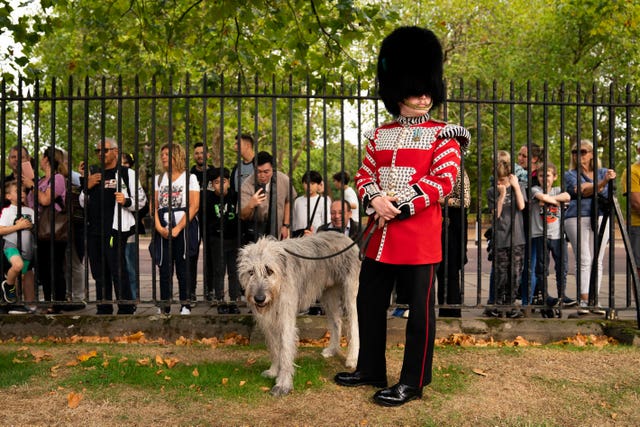
An Army battalion that played a key role in both world wars has been reactivated in a bid to “counter threats to worldwide peace”.
The Second Battalion Irish Guards, which was disbanded 75 years ago, will see new soldiers hone their “discipline and skills” by performing ceremonial duties.
Eventually, they will be sent into the First Battalion – currently training Ukraine’s armed forces to respond to the Russian invasion – and dispatched on global operations.
“The army, of course, is adapting to the changing world,” Major Niall Hall, Regimental Adjutant of the Irish Guards, told the PA news agency.
“It needs to be fleet of foot and this is a great example of that happening.”
On Friday, the Second Battalion’s No 12 company – made up of soldiers as young as 18 – performed its first ceremonial duty with the changing of the guard at Buckingham Palace.
“Things like this don’t happen often in the military,” said Ppr Jim Bell, one of the pipers to lead the group out of Westminster’s Wellington Barracks.
“I think it’s great that they’ve been raised because we get to carry their battle on us. And the men who fought and died within the Second Battalion will be remembered again.”
The battalion was formed during the First World War and first saw action at the Battle of Loos in the autumn of 1915.

One of its early members was John Kipling, son of the poet Rudyard Kipling, who was killed at Loos when assaulting a German position.
It was suspended after the Armistice, reactivated a few months before the Second World War, before being disbanded again in 1947.
More than seven decades later, members of the battalion performed drills in front of Wellington Barracks as members of the public watched from Birdcage Walk.
The guardsmen, wearing bearskin with a signature blue plume, stood to attention as they were inspected by senior officers, who occasionally brushed down their scarlet tunics.
“We’ve been training all of this week to get it all squared, to get it all up to scratch for the lads,” Todd Yates, a 19-year-old guardsman, said.
The regiment’s mascot, a two-year-old Irish wolfhound known formally as Turlough Mor – nicknamed Seamus – drew particular interest from the crowd.
“Are you here because the dog is going to retire?” one puzzled onlooker asked reporters.

Seamus – “one of the personalities in the battalion”, according to his handler – led the company and Irish Guards band along Spur Road and through the gates of the Palace.
Skidding at times on the front courtyard’s red gravel, they took the place of the Coldstream Guards slightly after 11am.
Arranging itself in a semi-circle inside the main gate, the band drew applause from onlookers thronging the nearby streets with a performance of Only The Good Die Young.
The Second Battalion was reactivated under the Future Soldier programme, which resulted from the Government’s review of the armed forces last year.
“Future Soldier and a series of subsequent plans detail how the Army will amend its force structure to deal with a changed operating environment caused by, among other issues, the Russian aggression in Ukraine,” the army said in a statement.
“In this way, the Army will be more able to counter threats to worldwide peace and stability.”


Comments: Our rules
We want our comments to be a lively and valuable part of our community - a place where readers can debate and engage with the most important local issues. The ability to comment on our stories is a privilege, not a right, however, and that privilege may be withdrawn if it is abused or misused.
Please report any comments that break our rules.
Read the rules hereLast Updated:
Report this comment Cancel